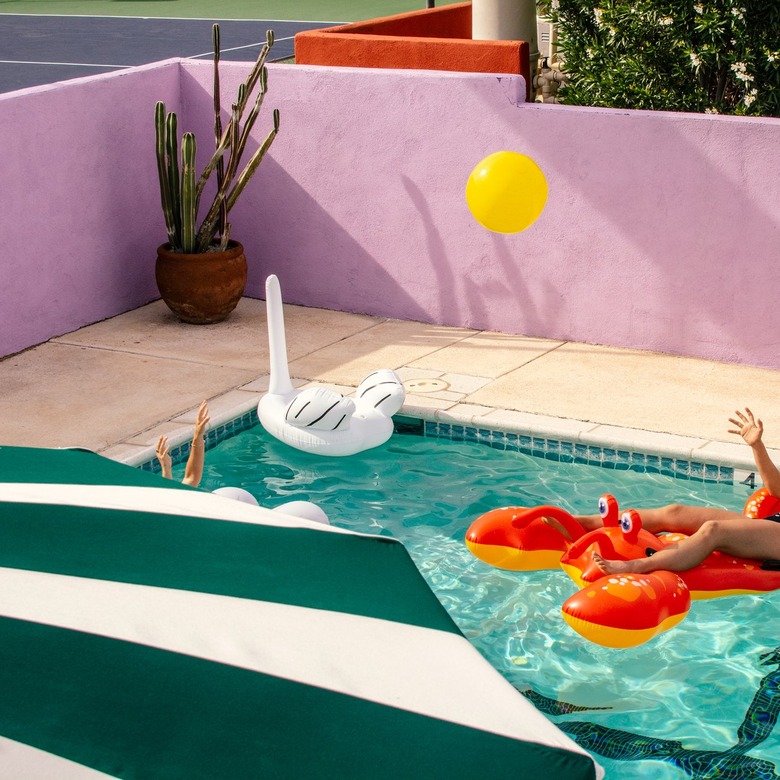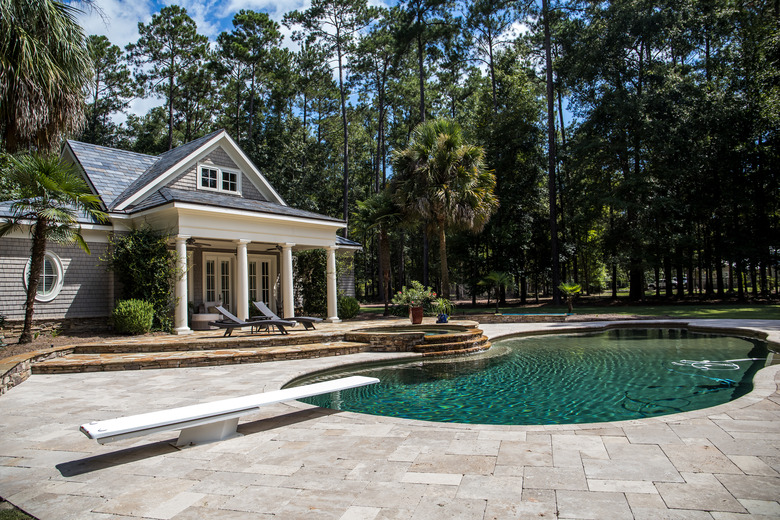A DIY Guide To Opening Up A Swimming Pool
We may receive a commission on purchases made from links.
After a long winter, a pool opening is an event worth celebrating, but you have to do it right, or the celebration could end with skin rashes and other symptoms of unhealthy water. The pool has been sitting idly for several months full of stagnant water, and the water has to be treated. You know this, of course, and you'll be shocking the water with a ton of chlorine, so just be sure the celebration doesn't start prematurely, which would be before the chlorine levels have fallen into the safe zone.
You'll also want to prepare yourself for the pool opening by gearing up with personal protective equipment, including goggles, rubber gloves and a respirator. You'll need this safety equipment to protect you from nasty pool chemicals, such as muriatic acid and pool chlorine, which send over 4,000 people to emergency rooms each year, according to the Centers for Disease Control and Prevention. It's just as important for you to be safe as it is for you to provide a safe experience for pool users.
During the multistep pool opening procedure, you'll be removing the cover; cleaning the pool; restarting the pool pump, filter system and — if you have a saltwater pool — the chlorinator; and balancing the chemistry of the pool water before you shock it, which is the last step. Each step in the procedure requires the preparation of one or more of the preceding steps, so it's important to follow all the steps in sequence. And though in-ground pools and above-ground pools are different sizes and are made of different materials, the opening procedure is essentially the same.
Remove the Pool Cover
Remove the Pool Cover
Unless your pool has an automatic pool cover, you're going to need help because most pool covers are too large for one person to handle. Before you do anything, you need to remove the water from the cover to keep it from getting in the pool. You can use a pool cover rake, but it's a lot easier to use a pool cover pump or just a regular sump pump. You'll also want to sweep any debris off the cover before you remove it.
To remove the cover, you have to lift — not drag — it off the pool to avoid tearing it, which is why you'll be glad to have a helper. Lay it flat in the yard and let it dry out. Then, before folding it and putting it away, sprinkle some talc or alkalinity increaser on one side to prevent mold and mildew. If the cover is torn or damaged, now is the time to buy a new one so you'll be ready when winter rolls around again.
Get the System Up and Running
Get the System Up and Running
With the pool cover gone, you'll have your first look at the pool water, and it isn't likely to be a pretty sight. It will be discolored and possibly full of debris. Don't worry — you're about to deal with that, and this procedure will give you a good start.
1. Clean the Surface of the Water
Start by skimming all the floaties off the surface of the water with a manual skimmer to prevent them from being sucked into the pump when you turn it on.
2. Top Up the Water
Add water with a garden hose. The pool cover isn't designed to prevent evaporation, and the level inevitably drops during the winter. Keep filling the pool until the level is about halfway up the opening of the pool skimmer. It's a good idea to screw a hose filter onto the end of the hose to avoid adding even more contaminants to the water than are there already.
3. Add Metal Sequestrant
Metals tend to collect in the water during the winter, and you add more if you don't use a pool filter. These unfortunately will stain the sides of the pool and the pool equipment. To prevent that, add stain inhibitor to the water following the instructions on the container.
4. Reinstall the Pool Equipment
Replace the ladders, diving board, hand rails and any other pool hardware you removed when you shut down the pool in the fall. If the equipment is well used, treat it with a mineral stain and rust inhibitor before reinstalling it, and it's always a good idea to lubricate screws and bolts.
5. Unplug the Circulation Pipes
Remove any winterizing plugs you installed in the circulation and return lines and the skimmers. If you placed ice compensators in the skimmers, remove them now.
6. Turn on the Pump
Reconnect any pipes you disconnected from the pump using plumbers' tape on screw connections to make a good seal. If the filter has an air-relief valve, open it, and if the pump has a multiport valve, turn it to WASTE. Switch on the pump and close the air-relief valve as soon as water starts to spurt from it. Once you're sure water is flowing through the system, turn the multiport valve to FILTER.
If the gauge on the filter spikes, turn off the pump immediately and check for obstructions. You may need to clean or backwash the filter, especially if you have a sand filter. Otherwise, let the pump run for a few minutes and listen for strange sounds. If the pool has a chlorinator or heater, now is a good time to turn them on to make sure they're working.
Establish a Chemical Balance at Pool Opening
Establish a Chemical Balance at Pool Opening
Warning
Make sure you're wearing your protective gear before handling pool chemical products and follow the instructions on the containers closely.
You're going to shock the pool water with chlorine to get rid of all that grunge you saw when you removed the cover, but before you do that, you have to test the water for alkalinity, pH and calcium hardness, in that order. If you don't do this, the chlorine you add to the water will be less effective than it should be. The best way to test the water is to take a sample to your local pool outlet, but you can also do it yourself with a test kit or test strips.
The pool water is balanced when these levels are achieved:
- Total alkalinity: between 80 and 120 parts per million (ppm)
- pH: between 7.2 and 7.6
- Calcium hardness: between 200 and 400 ppm
Pool water tends to become acidic over the winter as it sits stagnant, and the best way to raise it, assuming the total alkalinity also has to go up, is to add baking soda, but if the alkalinity is already high, raise the pH with soda ash, which has less effect on alkalinity. If the pH is too high, you can lower it with muriatic acid or dry acid (sodium bisulfate), and if the calcium hardness is low, add calcium hardness increaser.
The Next Step Is Shocking
The Next Step Is Shocking
Now that you've established a balance in the swimming pool chemicals, the last thing you need to do is to introduce a whole lot of chlorine at once, which will take care of the algae and bacteria discoloring the water once and for all. Typical free chlorine levels in healthy pool water are between 1 and 3 ppm, but you're going to add enough chlorine shock to raise the level to 5 ppm or even higher. This will obviously make the water unsuitable for swimming, so don't plan on using the pool until the chlorine concentration has fallen to a safe level, which will take a day or more.
Pool shock doesn't work if the chlorine breaks down too quickly, and since this happens in direct sunlight, the best time to add shock is in the early evening so the chemical has the entire night to work. It's also a good idea to use a product that includes a stabilizer to forestall the UV degradation of chlorine. The proper dosage is typically 1 pound of shock per 10,000 gallons of pool water but check the instructions on the label just to be sure. You might consider double shocking — as many pool pros recommend for a pool opening — which means doubling the recommended dosage.
You need to be wearing your protective gear when you shock the pool. The product comes in granules, and you can simply walk around the edge of the pool and pour them directly into the water, or you can dissolve them with water in a 5-gallon bucket and pour the solution into the pool. If you use the bucket method, do not use the bucket to mix any other cleaning or sanitizing products, as combining chlorine with other chemicals can release dangerous fumes or even cause an explosion. Turn on the pool pump after shocking and leave it on for at least 24 hours to be sure the sanitizer circulates throughout the pool system.
Complete the Pool Opening
Complete the Pool Opening
If all goes well, the pool water should be clear enough on the next day to allow you to see all the debris on the bottom that you missed when you did the preliminary pool cleaning, so you'll want to spend some time vacuuming it out. You can also use the vacuum to remove fuzzy growth from the sides of the pool, although there shouldn't be much to remove if the shock was effective. However, if the water had been particularly dirty, this residue as well as cloudiness in the water may be due to the carcasses of dead microbes, and since you can't kill the microbes twice, you may need to add flocculant to the water to remove them.
Pool flocculant (floc), which is a supercharged type of pool clarifier, works by binding onto the microscopic particles, causing them to coagulate and drop to the bottom of the pool. It may take two or three days for this process to complete when using pool clarifier but only a couple of hours if you use floc, after which you remove the residue from the bottom of the pool by vacuuming. Because the water you vacuum out has to go to waste, you'll have to top up the water level in the pool, and you'll have to clean the pool filter. If you have a cartridge filter, opt for pool clarifier instead of floc.
Sometimes, you can't get rid of the greenish or brownish tinge in the water, which means that algae are still active, and that's a bad sign because they will just multiply if you don't do something. That something is to add pool algicide, and if your pool is in full sun, you should have a few bottles of this on hand for periodic treatments throughout the summer. Follow the instructions on the label to ensure you use this product properly and that it gives the intended results.
References
- Leslie's Pools: How To Open Your Pool in Spring
- Swim University: How to Open an Inground Pool in 13 Steps
- Centers for Disease Control and Prevention: Pool Chemical–Associated Health Events in Public and Residential Settings — United States, 2003–2012, and Minnesota, 2013
- Swim University: How to Open an Above Ground Pool in 11 Steps
- SwimmingPool.com: Pool pH: High and Low Fixes
- Swim University: Pool Clarifier vs. Pool Flocculant: What's the Difference?

